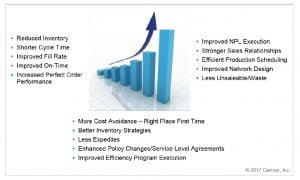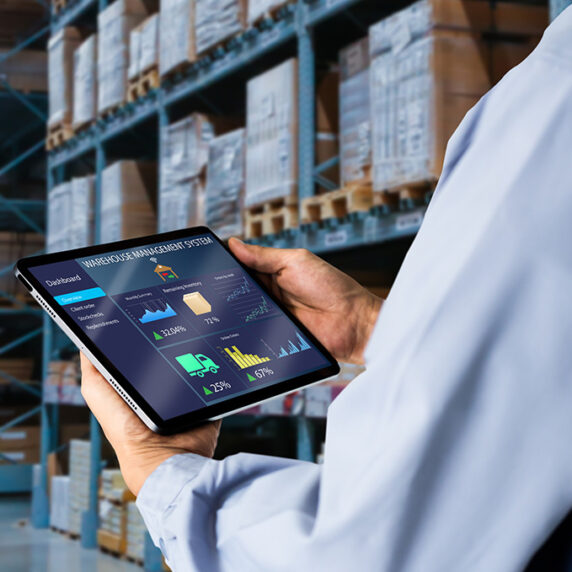Four Prerequisites for Demand Sensing Success
In a previous popular blog we described the key components of a demand sensing solution, which helps improve near-term forecasts by leveraging detailed, short-term demand data. It’s a great competency for any business—to be able to grab downstream demand data, identify trends, get a heads-up on looming problems, and minimize supply chain latency.
But there are some building blocks required for adding demand sensing to your supply chain, and Steve Steutermann helps identify them in a recent Gartner research note entitled When Will Consumer Products Companies Be Ready to Make a Demand-Sensing Investment? Steve identifies several organizational and system prerequisites that help ensure demand sensing success.
1. Access to Timely Downstream Data
Success depends upon your ability to draw upon timely downstream data such as channel data, point-of-sale tallies, or even market data from social sensing. The closer you can get to the end customer the better. But you don’t have to jump there all at once. For instance, a phased approach often looks like this:
- Start with channel data, such as “sell out” from a distributor or a downstream warehouse. Even “sell in” data can be helpful if you are not using it already. Individual orders or order-lines are more helpful than a simple aggregated demand number. Leveraging data about whom you sold to, how much you sold, and through what channel yields better forecasts than just knowing how many units were sold overall. This is a first step that is available to almost any company.
- The next step is usually accessing end user or POS data. An important reminder here is that you do not need a complete set of data in order to drive benefits. For example, Gartner says consumer products companies using POS data say they can benefit from visibility into as little as 40% of their POS data.
- The most advanced approach is not just sensing demand, but sensing the early indicators and market conditions that drive the demand. This could be market economic indicators like housing starts or exogenous (i.e., external) variables like climate or weather. It could also be web data such as page views, product spec sheet downloads, or even social sensing. Because this data is voluminous, incomplete and messy, some form of machine learning is often part of this phase.
Sometimes the problem isn’t the data, it’s the access. When the data isn’t useful in raw form, it may require a Demand Signal Repository (DSR) to cleanse the data for analytics. A DSR is a centralized database that collects, stores, harmonizes and normalizes data attributes. It organizes large volumes of demand data such as point-of-sale data, wholesale data, warehouse data feeds, inventory movement or promotional data. Demand signal repositories by themselves don’t turn demand signals into data insights—but they provide data access for a demand sensing solution.
2. Ready for Mature Demand Management
For effective demand sensing, Gartner recommends what it calls “Stage 3” maturity in demand management. This means you have a supply chain planning system of record (SOR), and each month you create consensus demand plans with an 18-24 month horizon. At this level, colleagues from demand planning, business, and supply chain have demarcated roles in developing the consensus demand plan, and are held accountable. Their inputs are measured and compared to actual demand, to identify sources of forecast error and improve performance.
We have seen many companies that started at a lower maturity level, but were committed to moving quickly to a more mature approach. For instance, Costa Express literally went from hundreds of spreadsheets to low-latency demand sensing in a single bound. But they were also totally committed to quickly achieving mature and advanced demand management.
3. Capable of an Agile Supply Chain Response
There’s no point in increasing accuracy and reducing latency in your demand signals if you can’t run your supply chain with a 0-8 week planning horizon. “Initiatives such as shorter production cycles, more frequent production schedules, and improved factory changeover speed are key indicators a CP company may be ready for a demand-sensing solution,” the Gartner report says.
4. Able to Make a Business Case
Finally, you have to be able to make the business case—with quantifiable benefits from an improved forecast—that justifies a demand sensing solution. For example, companies have increased customer service (improving fill rates, on-time delivery, and perfect order performance), reduced overall inventory and safety stock, less obsolescence and unsalable product, and reduced expediting costs. Quantify your case with such improvement numbers. Many times the business benefits are manifested in the supply chain response, again highlighting the need to couple demand sensing with supply chain agility.
A more mature your demand management capability may require less of a business case, Gartner says. That’s because, at a certain level of demand management maturity, demand sensing is simply “a necessary business requirement to conduct business, improve the forecast, place your organization on a path to pull-based replenishment, and orchestrate effectively across trading partners.”
Some of the potential benefits from demand sensing, according to Gartner

Source: When Will Consumer Products Companies Be Ready to Make a Demand-Sensing Investment?, Steve Steutermann , February 2017






